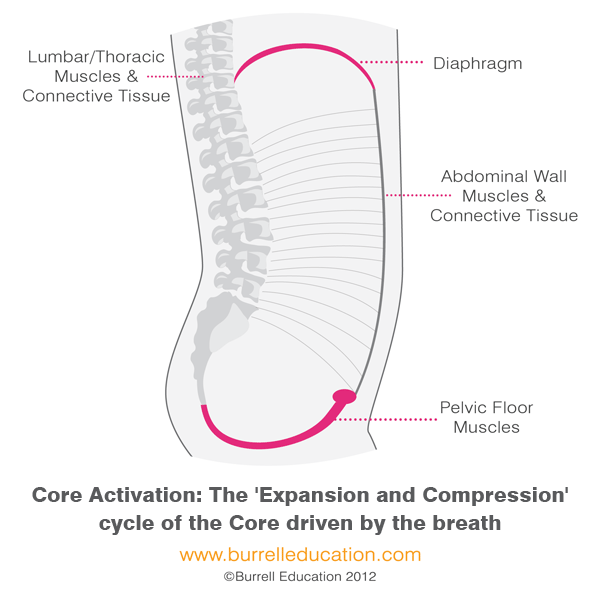Thoracic Spine, Pelvic Floor & Breath Connections
Jan 26, 2023
Written By: Dr. Malerie James, PT
What does the pelvic floor, thoracic spine, breath, and pressure management all have in common?
Sounds like the start to a bad joke, right?
The pelvic floor, the breath, and the thoracic spine (or mid back) are inextricably linked. If one isn’t moving well, the other(s) may be affected. When we take a deep breath in, our diaphragm flattens out to help the lungs fill with air. Often called “belly breathing” or “umbrella breathing”, this type of breathing is commonly underutilized unless in yoga class, exercising, or catching your breath. When our diaphragm flattens down, we can see and feel that we are taking a deep breath by noting the expansion of the belly and rib cage in all directions. Yes, ALL directions! This means that your pelvic floor should also be moving into excursion, or toward your toes. When you inflate a balloon, you expand on all sides, not just forward or to each side. The amount of movement in the pelvic floor with breathing can be hard to localize, especially if you have pelvic pain, a baby in the way, or just haven’t tuned into these muscles for a while. Practice finding awareness of your pelvic floor in different postures and positions like child’s pose, seated, or lying down and working into deeper belly breathing. This can help keep you in tune with your body and how it responds to different postures. One of the first things I assess when working with a new client is how they are breathing, followed by their preferred sitting and standing postures. No matter what their main concern is, I almost always find something we can work on in relation to the mid back and the breath.

https://www.alignforhealth.com/uploads/1/0/3/5/10350371/6174956_orig.gif
Research shows that increased forward curvature of the thoracic spine increases the pressure at rest on the pelvic floor, especially in older adult women. With a rounded back, there is less rib mobility, which reduces room for the lungs to expand, meaning the pelvic floor might be overstretched or inhibited in its full range. A rounded spine also impacts core strength and stability. The deep core muscle transverse abdominis connects to the fascia that originates at the thoracic spine. This can lead to all kinds of pelvic floor dysfunction. In a study from 2020, 100% of participants with self-reported bladder incontinence tested positive for hip and thoracic spine movement impairment! ONE HUNDRED PERCENT. Most commonly, the thoracic spine flexion was impaired, and hip adduction (more on the importance of your adductors in a coming blog post).
So what do we do to support our pelvic floor? Working on thoracic mobility (think yoga twists and backbends) as well as addressing the breath can be beneficial for finding the full range of motion and stretch in our pelvic floor muscles. Once we master the breath at rest, we can progress to more complex breath control, or pressure management. Being able to manage pressure in the body is an often overlooked aspect of continence, core stability, and strength output! When you think of a bodybuilder lifting heavy weights, you might imagine lots of muscle, grunting, and turning red in the face. All of that effort of supportive breath and pressures in the body adds up to being able to move a ton of mass! While your goals might not be to move 500lbs, having the ability to manage your intraabdominal pressure can help reduce risk of injury under high loads and impact activities, as well as keep you from leaking.
Balance can even be affected by the breath. Ever noticed yourself holding your breath when balancing over a single pinky toe on a slabby crux? Maybe you breathe out in a quick huff when you are about to hit a big drop on your MTB. A study of postpartum athletes showed that there is a significant change in the postpartum body response to balance challenges, and the response can be altered with glottis position changes. What the heck is a glottis? The glottis is the area of the throat that consists of the vocal cords and the opening between them. Breathing out without holding breath vs holding, vs vibrating glottis, such as talking, singing, or humming changes the body's ability to maintain balance.
References
Erbes, N.A. et al. (2021) “Movement impairments in women with and without urinary urgency/frequency,” Journal of Women's Health Physical Therapy, 45(4), pp. 164–173. Available at: https://doi.org/10.1097/jwh.0000000000000211.
Rudavsky, A. et al. (2022) “Certain voicing tasks improve balance in postpartum women compared with nulliparous women,” Journal of Women's Health Physical Therapy, 46(3), pp. 138–146. Available at: https://doi.org/10.1097/jwh.0000000000000242.
